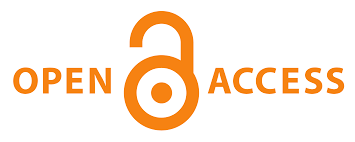Improving Students’ Speaking Ability Through Demonstration Method
(A Case Study of Junior High School Students)
Main Article Content
Yusridawati Yusridawati
This study is a case study for Class IX-1 Students of SMP Negeri 12 Lhokseumawe. Through learning procedure text, students can improve their ability in speaking English by demonstrating how to do something. This study uses a qualitative approach to obtain data and analysis through reflective and participatory studies. Program development is based on data and information from students and teachers through two stages of the classroom action research cycle. In the first cycle, students were seen to be quite active in learning. From the observation, it was found that student activity reached 77%. Furthermore, in the second cycle, student activity continued to increase until it reached 86% so that it increased by 9%. The increase in student activity was followed by an increase in learning outcomes, namely in the first cycle the average value was only 69, increasing to an average of 75 in the second cycle. From the implementation of CAR in cycles I and II, it can be concluded that through the application of the demonstration method, it can improve student achievement in learning English in class IX-1 of SMP Negeri 12 Lhokseumawe.
Candrasari, R., Dewi, R., Rizki, D., Meliza, R., Al Usrah, C. R., & Fasya, T. K. (2021, January). Learning Communication Strategy at Colleges During the Covid-19 Pandemic and the New Normal Phase. In International Conference on Social Science, Political Science, and Humanities (ICoSPOLHUM 2020) (pp. 18-23). Atlantis Press.
Farahdiba, S., & Asrifan, A. (2016). Speaking Ability and Psychological Barriers of the Second Year Students of Hotel Department of SMKN 1 Sidenreng Kabupaten Sidrap in Speaking English. Asian EFL Journal, 89, 41.
Hamidy, A., Fathoni, M. I., Pu, M., & Ilham, M. (2016). Android maze game for children as an autism therapy. Science and Engineering, 3(1).
Laben, A. L. (2017). The Use of Demonstration Method to Improve the Students’ English Vocabulary at the First Year of MAN 1 Makassar (Doctoral dissertation, Universitas Islam Negeri Alauddin Makassar).
Lestari, N. (2019). Improving the Speaking Skill by Vlog (video blog) as Learning Media: The EFL Students Perspective. International Journal of Academic Research in Business and Social Sciences, 9(1), 915-925.
Nuraini, N. (2020). ELF AND IT’S IMPLICATION TO LANGUAGE TEACHING IN THE CLASSROOM. Journal of English Teaching, Linguistics, and Literature, 1(1), 40-51.
Parveen, B. W. (2016). Use of technology in improving speaking skills. Journal of English language and literature (JOELL), 3(2).
Rahman, F. (2020). Bilingual Education vs English-only Approach at Australia’s Northern Territory Schools. REiLA: Journal of Research and Innovation in Language, 2(1), 1-7.
Rahman, F., & Saputra, N. (2021). English as International Language Revisited: Implications on South Korea’s ELT Context. Scope: Journal of English Language Teaching, 6(1), 08-15.
Sabat, Y., & Purwanto, H. (2015). Using Demonstration Method To Improve Students’ speaking Ability. English Educ, 3(1).
Sari, D. D. (2021). The Correlation Between Students’ Vocabulary Achievement and Fluency in Speaking English. English Teaching and Linguistics Journal, 2(1), 107-111.
Scanlon, L. (2018). The Role of Research in Teachers’ Work: Narratives of Classroom Action Research. Routledge.
Siregar, M., & Eswarny, R. (2020). Improving Students’ Achievement in Speaking Monologue Text by Using Video. Budapest International Research and Critics Institute-Journal (BIRCI-Journal) Vol, 3(2), 1343-1351.
Waliyani, W & Yuliani, S. (2018). "Improving Students’ Speaking Skills Through Demonstration Method Of The Class Xi IPS 1 Students Of Sma Muhammadiyah 1 Palembang." English Community Journal 2.2: 262-268.
Yuzar, E., & Rejeki, S. (2020). The Correlation Between Productive and Receptive Language Skills: an Examination on Adfelps Test Scores. SALEE: Study of Applied Linguistics and English Education, 1(2), 99-113.




